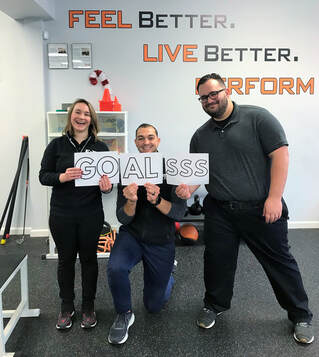|
Did you make a New Year's Resolution to improve your overall health and wellness? If so, good for you! Taking charge of your health is a great goal. But as we all know, the motivation we get from New Year's Resolutions can start to fade as the year goes on - in fact most resolutions don’t last past the month of January. This year, your resolutions don’t have to fizzle out because our physical therapists got together to offer some practical tips to help you achieve your goals and keep you moving forward!
Tony suggests:
Kyle suggests:
Above all else, we all wish you the best of luck in the new year!
1 Comment
People have been asking us how to eat healthier in this upcoming year so we came up with these easy tips to help you!
Ever wonder what it would be like to open your fridge to find a full week of healthy, delicious food that’s prepped and ready to be eaten? Sure would make sticking with your diet and achieving fat loss a lot easier… Meal prep is a fantastic way to keep on track with your eating throughout the entire week. The idea is to plan out all of your meals on the weekend, most often on Sunday, then do the shopping and the prep at one time for the entire week. This day is labor intensive, but then your food is ready-to-eat for the next 6 full days. Here’s my 5 Step Meal Prep Guide to make your next food prep week really simple: Step One: Planning Get out your notebook and pen or pull up a blank note page on your iPad, it’s time to start planning for the week. Here are the questions that you’ll need to answer: 1. How many meals do I need each day?
Now it’s time to translate those meals + servings into actual recipes. Take a moment to consider the produce that is in season and any special requests or food allergies. 1. Find your recipes
Take your list of recipes and create a grocery list. A few things to keep in mind… 1. Pay attention to recipes that you’ll double or triple
It’s time to head to the grocery store! Take your list and, if you’re lucky, a helper down to your local market and go through each section item by item. Step Five: Food Prep You have options when it comes to the actual prep of each of your meals. Many you’ll be able to fully make right away and pack in the fridge. Other recipes you’ll want to simply do the chopping, measuring and organizing in order to make the meal hot and quick before you plan to eat it. Which recipes should you fully cook in advance? The truth is that this is really up to you and your schedule. Here’s a good game plan if you don’t want to fully cook everything on Sunday:
By: Dr. Tony Tanzi, PT, DPT, CSCS Are your joints starting to feel stiff lately? Do they ache more than usual? Have you noticed any clicks and cracks coming from your knees?
If you’re struggling to put your finger on it and you’re not sure why it’s happening to you -chances are you’re not alone. Many people just like you are becoming a victim of knee and joint pain. This time of year (every year!) joint pain is one of the most common things we see and treat at Empire Performance PT. It starts with a few clicks of the knees every now and then. But nothing painful, and you think nothing of it. Then as time goes on, when your knees click it’s painful, and they start to ache a bit more (usually around the knee cap, and on the inside of your knee). Sometimes after you’ve walked around the stores for a few hours they begin to ache and feel sore. And getting back up again after relaxing with a cup of coffee on the couch, you notice it takes a few steps for your knees ‘to get going’ again... They can even make it difficult for you to get out of your car with ease. And when the cold weather hits the North East, your joints begin to feel even WORSE. So why does it happen? And why does it happen more to men and women aged 50+? Well there’s a WHOLE bunch of reasons that exist as to why joints in your body become more problematic in the Winter time. But the two most common reasons we see at the clinic are these: The cold weather naturally restricts the warmth of the blood that flows around your body, (which helps keep you warm and mobile). – AND – The fact you’re much less likely to keep as active and mobile in the Winter as you did in the warmer months. Keeping mobile is just like spraying WD40 on the stiff parts of a bike or car. Just like a vehicle needs oil to get you from A to B efficiently – your joints need to keep active so they don’t stiffen up. And here’s the thing that many people don’t realize – the winter months and long periods of inactivity, can be the root cause of many years of what I call – ‘all of a sudden’ life long knee pains. You see, as your muscles get a long rest this winter, there’s a chance they’ll become weaker and slowly get to the point where they won’t be able to support your knees. And worse yet, many people don’t even notice it happening until the pain sets in. But when it does, a chain of events is triggered and when your knees don’t have the support of strong muscles, problems like arthritis can set in. Which is why it’s so important to make the most of every opportunity you have this Winter to keep active, so you can fend off the curse of bad knees creeping up on you. I know it’s easy to think that when the weather begins to warm up you’ll exercise again. Problem is, very few people understand that your muscles need to be strong and stable to exercise safely! And if you go into tough exercise too quick, there’s a chance you’ll injure yourself and make those sore joints feel even worse! So my number one tip for you today to keep the winter aches away is to include some kind of activity in your day, everyday. It doesn’t have to be outdoors! You can go into an exercise class with friends, do low- impact movements that are kind to your joints like Pilates and Yoga from the comfort of your living room, and if you have an exercise bike (or something like that), use it while watching your favorite TV show. There really is something for everyone. What are you going to do to keep active this winter? At Empire Performance PT, we help patients daily with lower back pain, neck pain, shoulder pain, and knee pain… and it’s safe to say that imbalances in the body are typically the number one root cause of pain. If you’re feeling pain when you walk, get out of bed, exercise, or during your everyday life, this might be because something is out of balance – and it might not be an obvious problem. Imbalances often aren’t easy to spot, because not many people understand WHAT they are and how to recognize them (including most doctors!)… The most common advice you get for things like lower back, knee and neck pain not only fails to bring you the relief you’re after – but it can also make your pain WORSE. For instance, you might have heard from professionals, family members and friends that you need to “strengthen your back” to get rid of the pain… Whilst strengthening the area may be true in some cases, if the muscle imbalances associated with your pain have been there for a while and have been tight for months (… or even years!) then exercise will more than likely aggravate them even more. In this blog post, you’ll learn how to recognize your own imbalances, how they cause pain in different parts of your body, and what you can do to ease the pain that you just can’t seem to get rid of. How Do I Help My Neck Pain? Your neck pain often stems from the thing it sits on – your shoulders. Let me explain… An easy way to find out if you have problems with your shoulders is to stand in front of a mirror and see if one shoulder is higher than the other. If one of your shoulders is higher than the other, there is more than likely an imbalance, which means that there’s less room for your shoulder to move properly. When the tension builds up in your shoulder muscles, the pain is often sent to your neck. Stretch to help neck pain: Try the single-arm doorway stretch (see the below photo for an example of this stretch) – this stretch is used to open your chest muscles and create more room in your shoulder for movement, making them more flexible in the long run. To make this stretch more challenging, place your hand on the side of a doorway and lean forward to stretch your chest and shoulder further… but keep your feet flat on the ground. But what if your shoulders are even? Your pain or headaches could be coming from a forward leaning head… If you look in the mirror and you don’t see any imbalance in the height of your shoulders, turn to the side – if your head is leaning further forward than your shoulders, this could be limiting the amount of blood flow to your head and neck, which could be causing headaches. How Do I Help My Lower Back Pain? Much like knee pain, back pain often isn’t caused by your back at all. If one side of your pelvis is higher than the other, this can trigger back, hip, groin, and even knee pain. Unevenness in your hips can pull on your lower back, causing extreme tightness, especially whilst you’re sitting. Stretch to help fix this: Doing the right stretches will help reduce the pain and allow you to move freely once again. See below photograph for a great lower back stretch that you can try at home. If you want to fix these imbalances, you should consider asking for some help from a physical therapist. So many of our patients initially put off getting treatment as they believe the pain will ‘go away with time’, but then they come to us 6 months down the line with a problem which is much worse.
Many of our patients have found that since COVID started they’ve been suffering from more aches and pains than they did before, this is because we all stayed at home either working or spending our days in front of the TV. What Else Can I Do? You’ve made a great first step by reading this blog post! So many people procrastinate for so long, thinking that their pain will ‘just go away in time’, but then 6 months down the line they’re still waiting for that time to come… and their pain has actually got worse. Expert advice, exercises, and hands-on treatment provided by a physical therapist can help improve your pain, as well as improve posture and strengthen weakened muscles. Would you like to see a Physical Therapist for free? We realize some people want more than just some free health tips… That’s why we offer expert advice about the worry and frustration of life-changing aches and pains – for FREE, in under 30 minutes. Here are just a few of the things you will learn in one of our free discovery sessions: 1. What is the underlying cause of your back pain? (hopefully nothing too serious!) 2. Roughly, how long will it take to fix my problem? 3. What to do to help – which doesn’t include painkillers, resting or surgery etc. 4. What other, natural, drug-free methods are there to speed up recovery alongside treatment? Our discovery sessions are great for anyone that may be “unsure” if Physical Therapy is right for them, and they give you the opportunity to ask questions and see for yourself if we can help you. We’ve got 5 discovery sessions available this week. If you would like one of our limited discovery sessions, please get in touch with Chloe at 845-225-2000 and mention you would like a free discovery session. By: Dr. Tony Tanzi, PT, DPT, CSCS A lot of people, including our patients at Empire Performance PT, often underestimate the power of great posture, why your posture is so important, and the endless benefits it can have on your lifestyle. For most people, their time is more than likely spent sitting at a desk, in their car driving, standing up for long periods of time, lifting things, looking after kids, or sitting on the sofa watching the latest Netflix series. If you have bad posture doing these things throughout your day, and it isn’t dealt with correctly, it can seriously affect you and your lifestyle in the long run. This blog post is full of vital information about your posture, including what it is, why you need a good posture, and how to make sure you’re giving yourself the best chance at lowering your risk of neck, shoulder, and back pain as you get older. What Is Your Posture? Your posture is, quite simply, the position of your body. This is everything from the way you hold your body and the way your arms and legs move when you’re sitting, standing, and even lying down. Having a good posture means that you’re putting the least amount of strain on your muscles and joints, allowing proper blood and oxygen flow, and putting yourself at a lower risk of developing joint and muscle issues in the future. Why Is Posture So Important? Our posture is vitally important, by having good posture you relieve pressure off your back, keep your nerves and blood vessels healthy, and support your muscles, ligaments and tendons. People who look after their posture and hold themselves correctly are less likely to experience back and neck pain, which can lead to life-changing problems such as Sciatica. Having good posture involves training your body to stand, walk, and relax in a way where there is the least amount of strain on your muscles and ligaments whilst you’re moving, lifting things, sitting down, and sleeping. What Happens If I Don’t Look After My Posture? Great question! Poor posture can cause problems with blood circulation in your body, can cause chronic fatigue as you aren’t allowing your lungs to fill up with oxygen correctly, and cause chronic pain in your neck, back and shoulders. If you don’t watch your posture and the way you’re moving, this can cause long-term problems, which could end up leading to something called herniated spinal discs (slipped disks), sciatica, and misalignment throughout your entire body. These injuries would make everyday life a whole lot harder. What Can I Do To Improve My Posture? There are many things you can do to improve your posture and it’s great that you’re taking the correct steps to help your health, by reading this blog! The solution for fixing your posture lies not only in putting some (if not all) of these actions in place, but also by committing to these top tips for the long run. It may not be a quick fix but you will be easing your pain in the long-term. These healthy habits are something that everyone needs to incorporate into their life. Our Top Tips To Improve Your Posture And Prevent Back Pain… Here are our top 3 tips, plus a video from our therapist Ell, to help you improve your posture and prevent you from getting back pain! 1. Sit Up Straight This tip might seem obvious, but you’d be astonished by how many people go through their day-to-day life slouching, and not taking care of their back. If you have an office job, then adjusting your seating when you’re sat down for a long period of time is the first step to taking care of your back. The features of the chair you sit on are there for a reason – to make you feel supported! 2. Stand Up Straight If you stand up at work, then standing up as straight as possible really does help. I know it can feel like a relief to rest your body weight on one leg whilst giving the other leg a break, but this is pretty much how not to stand. Make sure that you’re spreading your body weight evenly across both legs… this helps to keep your posture right and helps you to feel more comfortable while you’re standing. 3. Move Get up and move! The best time to get up and moving is when you feel your body start to slouch a little and you begin to find it hard to keep a comfortable position. Try to get up from your chair every 30-minutes or so and do a few stretches or walk around for a few minutes. Think of this as a tea break for your body, once you’ve done this, you’ll more than likely feel refreshed and ready to start working again or to get on with your day. Try to stay as active as possible and ease yourself into exercising regularly. By: Dr. Tony Tanzi, PT, DPT, CSCS |
AuthorDr. Tony Tanzi: Physical Therapist, Triathlete, Runner, Performance Coach Archives
October 2022
Categories |






 RSS Feed
RSS Feed